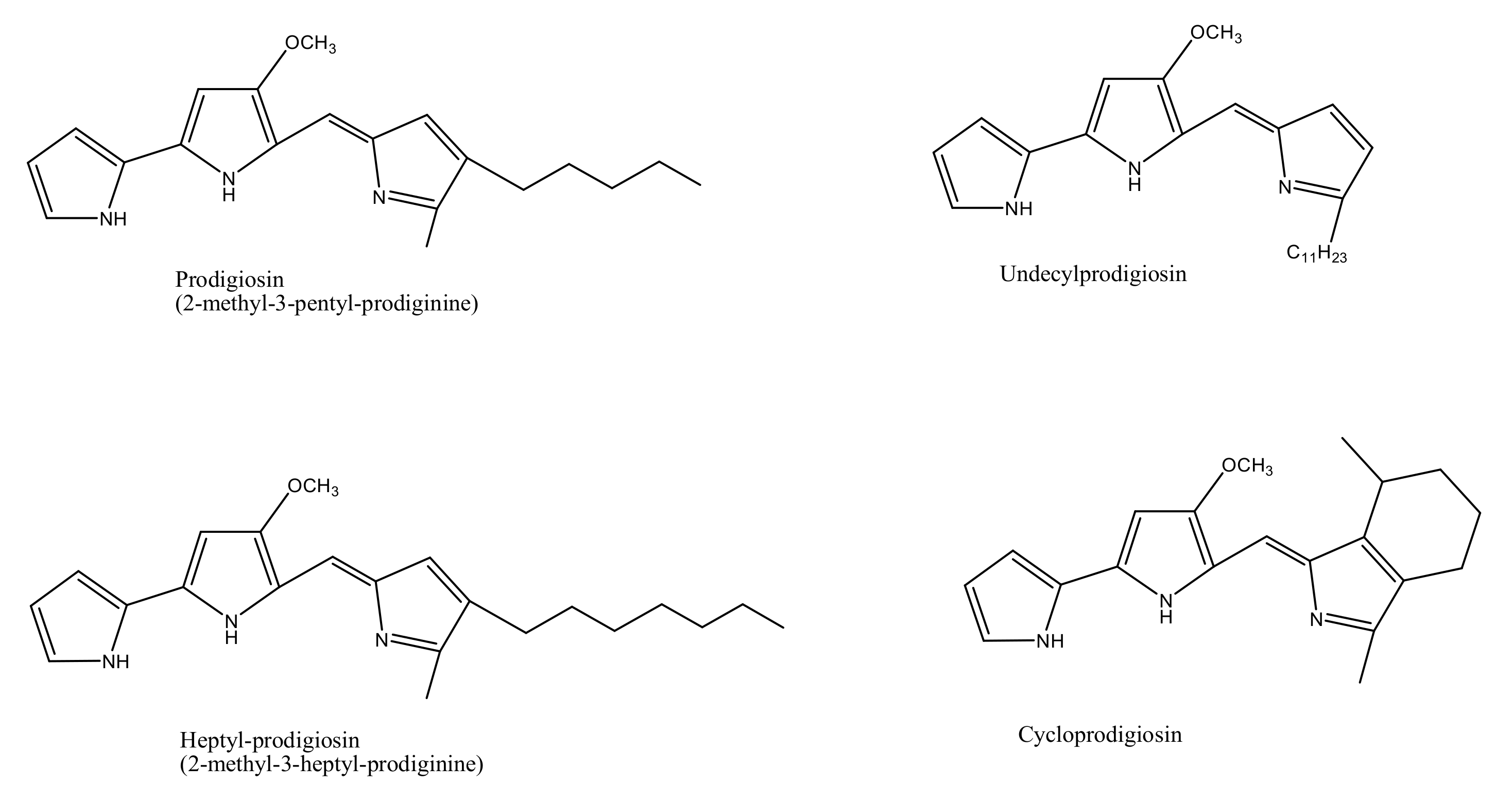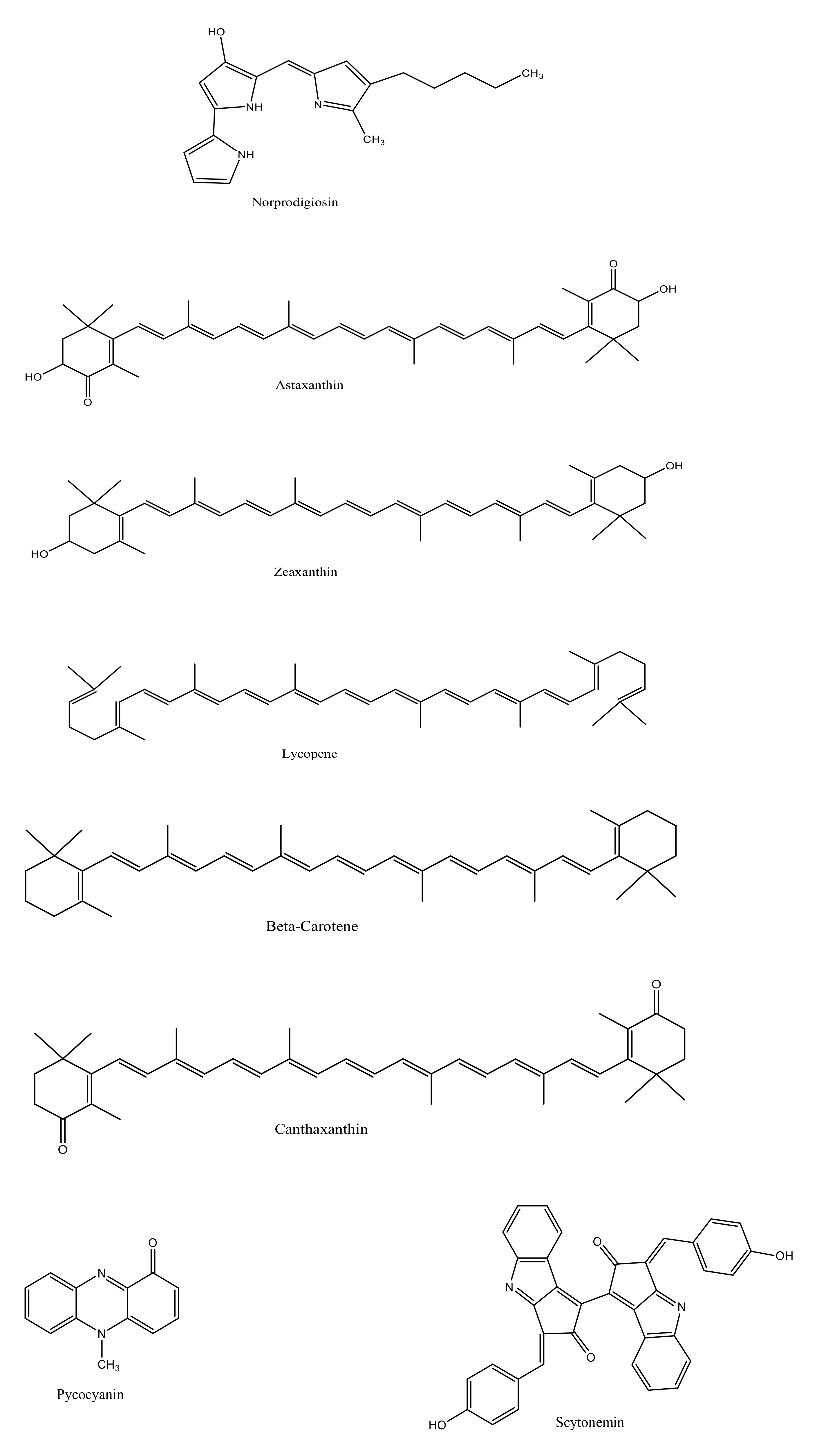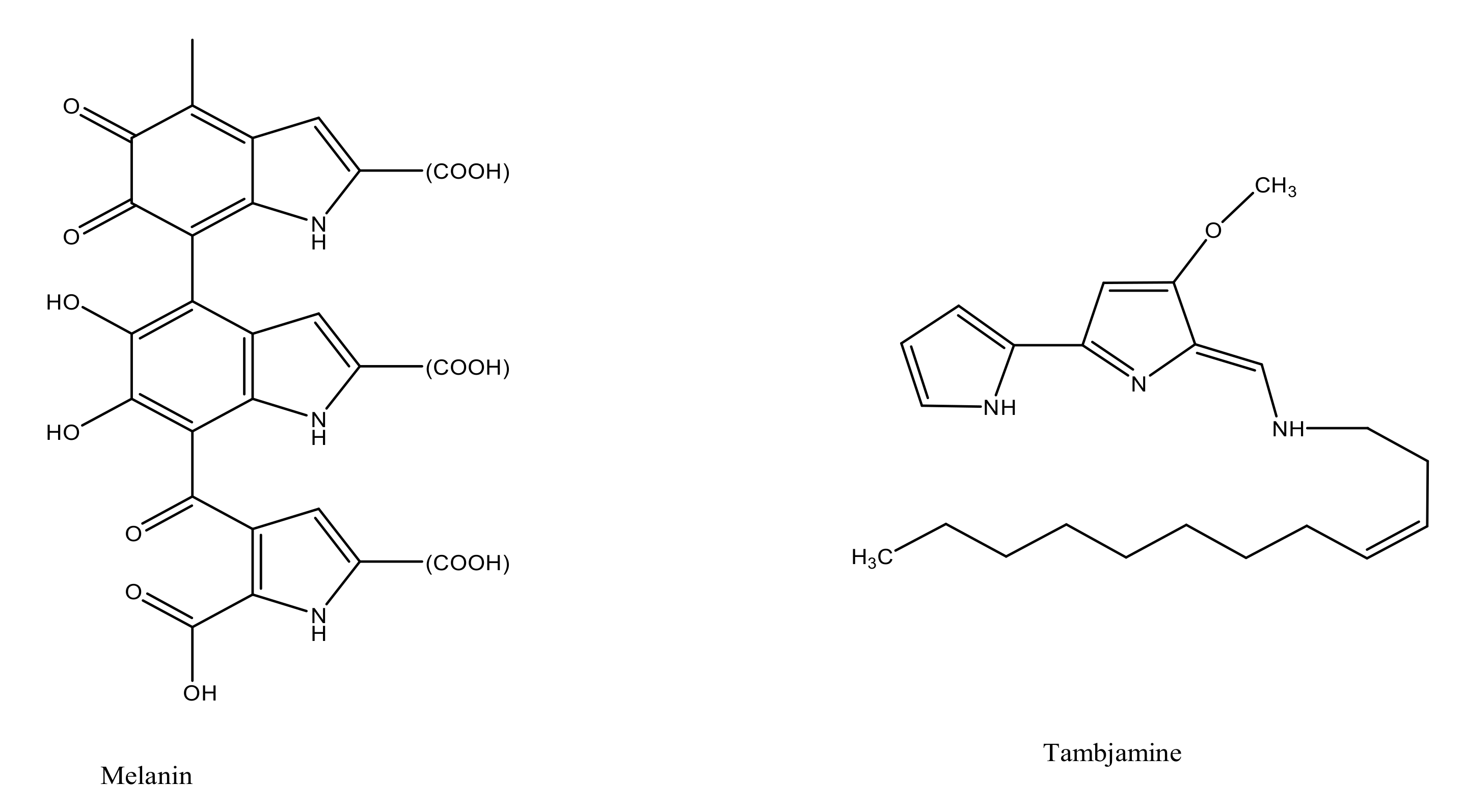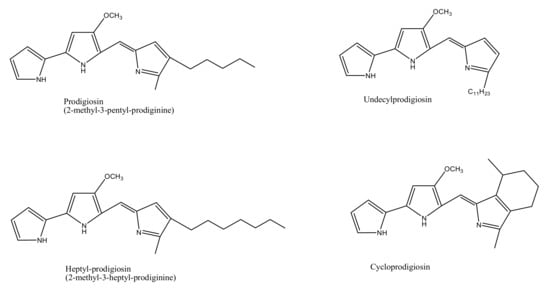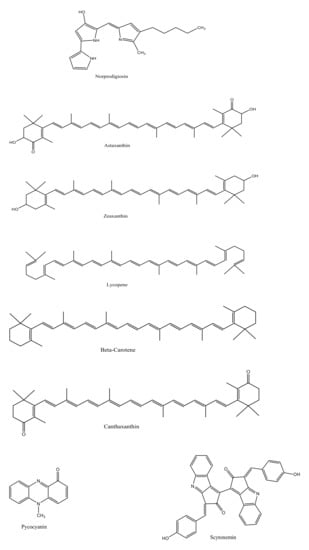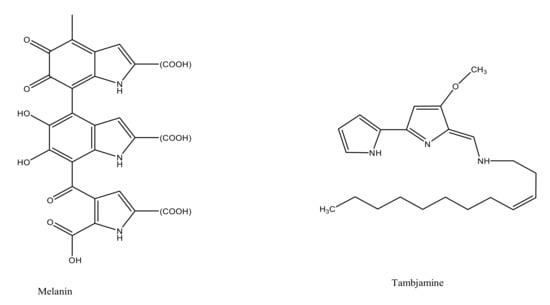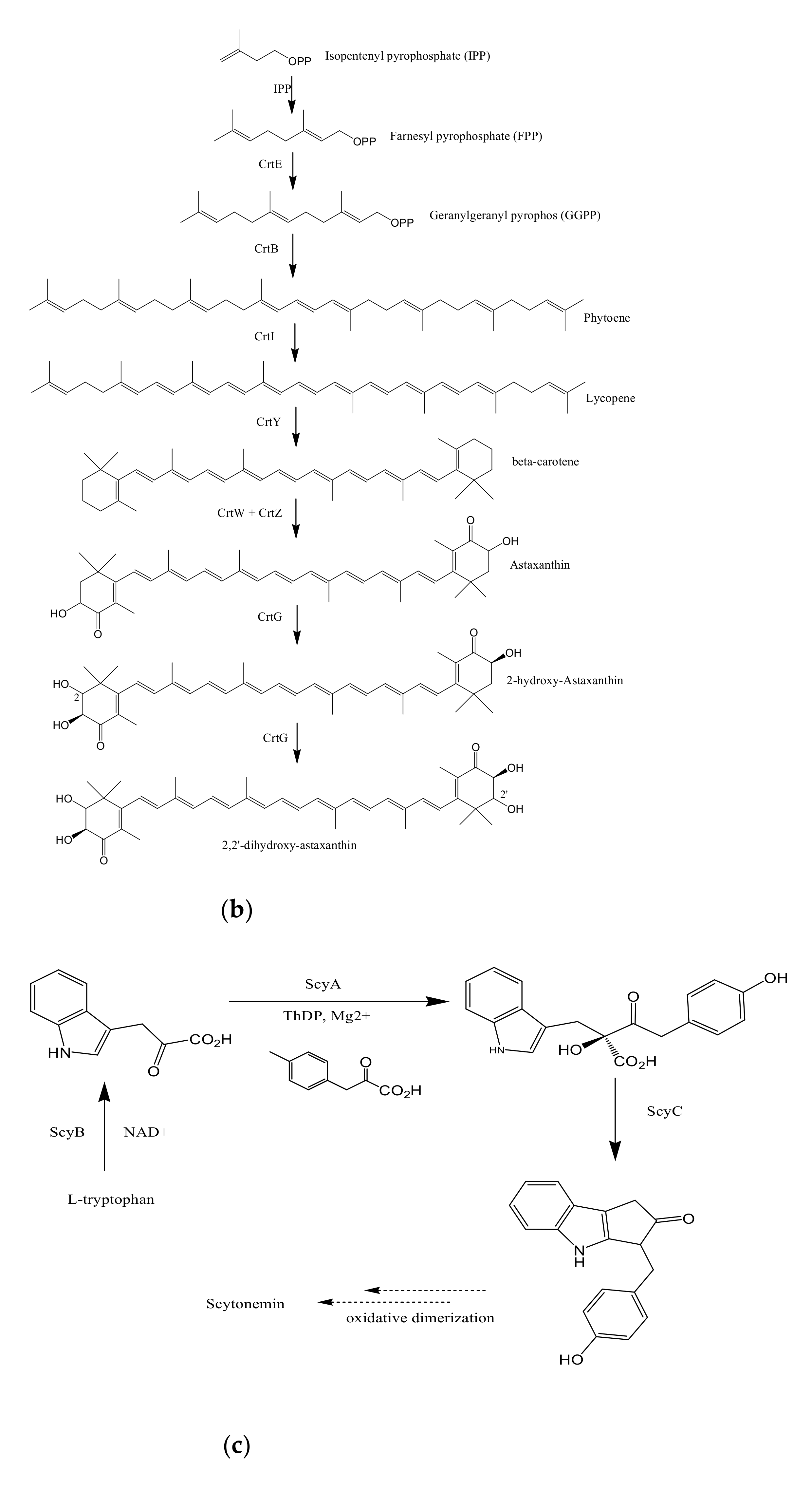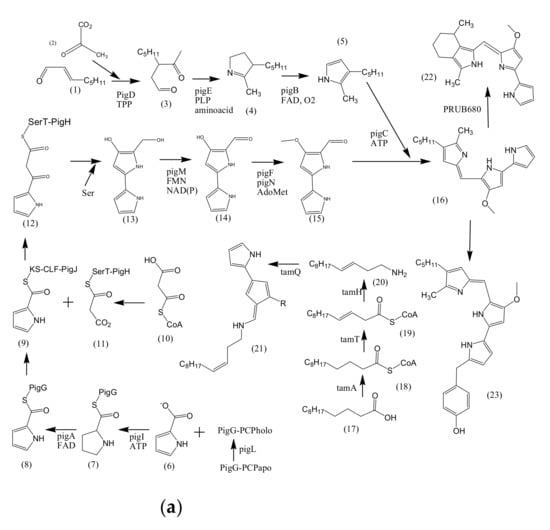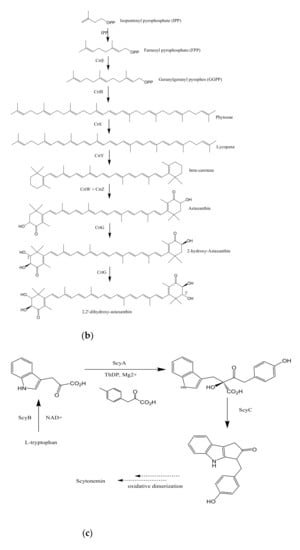4. Industrial and Therapeutic Applications
4.1. Therapeutic Applications
4.1.1. Antibacterial Activity
Antibacterial properties of various bacterially produced bio-pigments of marine origin have been reported against an array of bacterial species, e.g., prodigiosin, cycloprodiogisin (from
Z. rubidus sp. S1-1), and the yellow pigment (extracted from
Micrococcus sp. strain MP76) have shown antibacterial activity against
Staphylococcus aureus sp. and
Escherichia coli sp.
[65][66][98,99]. Other bacterial strains that are reportedly inhibited by prodigiosin and cycloprodigiosin are
Bacillus subtilis sp. and
Salmonella enterica serovar Typhimurium
[65][98]. Likewise, the yellow pigment has shown activity against
P. aeruginosa sp. as well
[66][99]. Norprodigiosin synthesized by marine
Serratia sp. has also been reported to exhibit inhibition activity against
Vibrio paraheamolyticus sp. and
B. subtilis sp.
[17][32]. These studies strengthen the utilization of bpBPs as potential alternatives to synthetic medicinal compounds.
Furthermore, inhibition activities recorded against
Citrobacter sp. by pyocyanin and pyorubin
[43][58] and
P. aeruginosa sp. by violacein pigment (purified from Antarctic
Iodobacter sp.)
[67][100], further stretches the range of marine-derived bpBP’s potential against pathogenic bacterial species to opportunistic bacterial species. There are numerous correspondingly published studies. The pigment “melanin” from marine
Streptomyces sp., for instance, demonstrated antibacterial activity against
E. coli sp.,
S. typhi sp.,
S. paratyphi sp.,
Proteus mirabilis sp.,
Vibrio cholera sp.,
S. aureus sp., and
Klebsiella oxytoca sp.
[53][68]. A bright pink-orange colored pigment extracted from
Salinicoccus sp. (isolated from Nellore sea coast) also showed antimicrobial potential against several bacterial strains including
E.coli sp.,
Klebsiella pneumoniae sp.,
B. subtilis sp.,
Proteus vulgaris sp.,
P. aeruginosa sp., and
S. aureus sp.
[68][101]. Hence, these and similar other studies all indicate the exploration of marine bacterial species as a dynamic approach to derive antibacterial compounds.
4.1.2. Antifungal Activity
Studies have also been carried out to determine the antifungal potential of natural pigmented compounds. Several studies have reported the antifungal activity of marine-derived bacterial pigments, among which violacein from
Chromobacterium sp. and prodiginine pigments (prodigiosin and cycloprodigiosin) extracted from Indonesian marine bacterium
P. rubra sp. reported to exhibit antagonistic activity against
Candida albicans sp.
[7][69][23,103]. Violacein also inhibited several other fungal strains, including
Penicillium expansum sp.,
Fusarium oxysporum sp.,
Rhizoctonia solani sp., and
Aspergillus flavus sp. Studies have also reported that violacein (extracted from a pure
Chromobacterium sp.) shows comparable antifungal activity to that of bavistin and amphotericin B, highlighting the potential of marine-derived bpBPs as effective antifungal agents over existing synthetic antifungal compounds
[69][103].
4.1.3. Anticancer Activity
Exploring anticancer compounds from marine microbes has been considered a hot spot in natural product research. Several studies have been carried out in order to examine the antitumor ability of marine bacterial pigments. Anticancer activity of marine-derived bpBPs has been explored against several cancerous cell lines. Astaxanthin and 2-(p-hydroxybenzyl) prodigiosin (HBPG) isolated from
P. kolensis sp. and
P. rubra sp. displayed significant cytotoxicity against human breast cancer cell line (MCF-7) and human ovarian adenocarcinoma cell line, respectively
[23][70][38,104]. PCA (Phenazine -1-carboxylic acid) pigment extracted from marine
P. aeruginosa sp. GS-33 correspondingly showed inhibition against SK-MEL-2 (human skin melanoma cell line)
[71][105]. Another pigment violacein extracted from Antarctic bacterium isolate, identified as a member of the genus
Janthinobacterium (named as
Janthinobacterium sp. strain UV13), revealed its antiproliferative activity in HeLa cells.
4.1.4. Antioxidant Activity
Marine-derived bpBPs are also being explored for their antioxidant activity. 3R saproxanthin and myxol pigments (from marine bacterium belonging to genus
Flavobacteriacae) exhibited antioxidant activity against lipid peroxidation and also showed neuroprotective activity against L-glutamate toxicity
[72][110]. The antioxidant activities of zeaxanthin (extracted from marine bacterium of genus
Muricauda)
[73][111] and melanin (from marine
Pseudomonas stutzeri sp.)
[74][112] have also been identified. Another pigment, phycocyanin extracted from marine bacterium
Geitlerinema sp TRV57, demonstrated appreciable antioxidant activity
[75][113]. Crude pigment extracted from the marine bacterium
Streptomyces bellus sp. MSA1 also displayed 82% of DPPH (2,2-diphenyl-1-picryl-hydrazyl-hydrate) activity and said to exhibit radical scavenging activity
[76][114]. Likewise, pigment crude extract from
Zobellia laminarie sp. 465 (isolated from sea sponge) reported to exhibit high antioxidant values for ABTS-L (capture of the 2,2-azino-bis(3-ethylbenzothiazoline)-6-sulphonic acid (ABTS
+) radical of the lipophilic fraction)
[77][115], suggesting the importance of marine derived bacterial pigments in pharmaceutical and medicinal industries.
4.1.5. Antiviral Activity
The advancing viral pandemics have taken a toll over the limited pool of existing antiviral agents, which has led to a rigorous search for newer, natural compounds with better antiviral capacities. Various studies on marine bpBPs suggest them as potential candidates. Prodigiosin extracted from
Serratia rubidaea sp.
RAM_Alex showed antiviral activity against hepatitis C virus (HCV) upon injecting HepG2 (human liver cancer cell line) cells with 2% of HCV infected serum
[78][116]. Other carotenoid pigments (from
Natrialba sp. M6) have also displayed complete elimination of HCV and clearance of 89.42% of hepatitis B virus (HBV)
[79][117], indicating the use of marine pigments as availing antiviral agents.
4.2. Industrial Applications
4.2.1. Bio-Pigments as Food Colorants
Researchers have concluded that marine-derived bpBPs can be utilized to provide full-scale commercial production of food-grade pigments, owing to their little or no threats to consumer health. They also showed pleasant colors at low concentrations. Pyorubrin and pyocyanin, for example, extracted from
P. aeruginoasa sp., when assessed for their utilization as food colorings with agar, gave pleasing colors at 25 mg mLG
−1 [43][58]. The utilization of bpBPs was also suggested as a feed additive to promote growth and enhance the coloration of ornamental fishes
[80][119]. Furthermore, prodigiosin (from marine bacterium
Zooshikella sp.) has been reported to exhibit good staining properties and a three months shelf life
[81][120], which hints toward a sustainable aspect of marine-derived pigmented molecules as food colorants.
4.2.2. Bio-Pigments as Dyeing Agents
The worldwide demand for clothes is rising exponentially. Newly, there is an increase in the insistence of incorporating antimicrobial properties in fabrics. Lee et al. identified a novel marine bacterium
Z. rubidus sp. S1-1 that produced two significant pigments, i.e., prodigiosin and cycloprodigiosin. These were used to dye cotton and silk fabrics. Results revealed that the application of red-pigmented extract solution on fabrics reduced the growth rate of
S. aureus sp. KCTC 1916 by 96.62% to 99.98% and
E. coli sp. KCTC 1924 by 91.37% to 96.98%
[65][98]. Furthermore,
Vibrio sp. isolated from marine sediment produced a bright red colored prodiginine pigment that was used to dye nylon 66, silk, wool, acrylic, and modacrylic fabrics to obtain a pretty deep-colored shade. The dyed silk and wool fabrics also showed antibacterial activity against
E. coli sp. and
S. aureus sp.
[82][121]. Researchers at Ulsan National Institute have also reported the synthesis of antibacterial fabric by using violacein pigment extracted from
C. violacea sp.
[83][84][122,123]. Prodigiosin pigment extracted from
Serratia sp. BTWJ8 effectively dyed paper, PMMA (Polymethyl methacrylate sheets), and rubber latex. Rubber is commonly used in day to day life either in houses or industries. PMMA have been widely utilized for the construction of lenses for exterior lights of automobiles. Different concentrations of prodigiosin produced variable color shades that revealed its affectivity as a coloring agent
[85][124].
4.2.3. Use in Cosmetics
The cosmetic industry is an expeditiously emerging global business market. About 2000 companies in the United States of America are cosmetic manufacturers. It is estimated that American adults use seven different skincare products per day for everyday grooming
[86][125]. The cosmetic industry has a worth of 10.4, 10.6, and 13.01 billion euros in the UK, France, and Germany, respectively
[87][126]. Considering the cosmetic market value worldwide, researchers have also made efforts to explore the use of marine-derived bpBPs in skincare products. The addition of the pigment PCA in a solution of commercial sunscreen enhanced its UV-B (ultraviolet B-rays) protection and increased the SPF (sun protection factor) values up to 10% to 30%
[71][105].
Similarly, melanin incorporated cream (named cream F3) was synthesized by concentrates of seaweed (
Gelidium spinosum) and melanin pigment (extracted from marine bacterium
Halomonas venusta sp.). Cream F3 showed high SPF values and photoprotective activity and demonstrated great effectivity in wound healing as well. Moreover, the formulated cream also exhibited antibacterial activity against skin pathogens;
Streptococcus pyogenes sp. (MTCC 442), and
S. aureus sp. (MTCC 96)
[88][127]. Another research reported the effectivity of melanin (extracted from marine bacterium
Vibrio natriegens sp.) in protecting mammalian cells from UV irradiation. Results revealed 90% survival rate of HeLa cells in melanized cell culture
[89][128]. In another report, Bio lip balm made from crude pigment (extracted from
S. bellus sp. MSA1) in a mixture of coconut oil, lanolin, and shredded bee wax
[76][114] suggested the use of melanin pigment as a significant ingredient in several beauty care products as well.
4.2.4. Antifouling Agent
Billions of dollars have been spent each year to control fouling activities on different objects placed in the marine environment. Biofouling on ships such as dreadnoughts increased the roughness of the hull, which promotes frictional resistance, ultimately leading to an increase in fuel consumption and other corresponding environmental compliances. Heavy metal-based antifoulants cause severe environmental complications, which further mandate the need for “eco-friendly” antifouling agents. Researchers have also revealed the use of marine-derived bpBPs for their role as an antifouling agent, for instance, prodigiosin extracted from
Serratia. sp. was reported to exhibit antifouling activity against marine fouling bacterial species such as
Gallionella sp. and
Alteromonas sp. It also inhibited the adhesion of
Cyanobacterium sp. on the glass surface
[90][129]. Likewise, another pigment, polymelanin synthesized by the marine bacterium
P. lipolytica sp., prevented metamorphosis and decreased the invertebrate larval settlement
[91][130], hence indicating the role of marine bacterial pigments as potential antifoulants.
4.2.5. Photosensitizers
The use of prodigiosin has also been reported as photosensitizers in solar cells. The high photostability of extracted prodigiosin demonstrated its use as a sensitizer in dye-sensitized solar cells (DSSC)
[92][131]. This study suggests the viability of bpBPs in addition to that of prodigiosin for the construction of cost-effective and low tech industrially produced DSSC.
